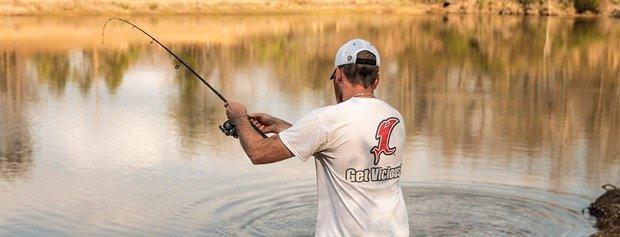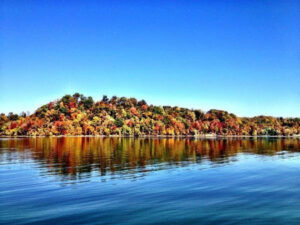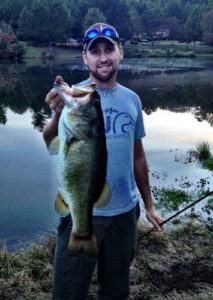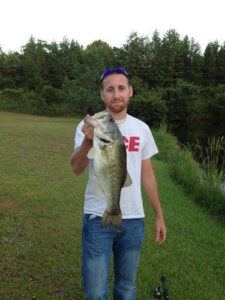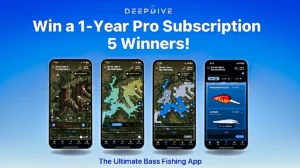I’ve fished all around the country throughout my life, but I often feel most at home when I’m fishing on the muddy shores of a farm pond. Like many anglers, this is where my passion for the sport started, and I always enjoy going back to my roots and chasing pond fish. When time is limited and I need to get a quick “bass fix” in before dark, you can bet that I’ll be in my boots somewhere on the bank.
Over the years, I have done some pretty crazy things to cast towards hard-to-reach places from the bank—whether it’s running like Forrest Gump from irate angus cows, climbing trees to flip a jig into a blowdown or wading into leech-infested water to reach a stump flat with a spinnerbait, I’ve certainly tried it.
Instead of putting your physical well-being in jeopardy, these four simple bank fishing tips will help all anglers catch more fish while having a ton of fun in the process.
Break out the Carolina rig
Let’s all go ahead and let out a collective moan to express our dislike of the C-rig. I’m right there with you. While Carolina rigging has a reputation for being a boring, uninteresting fishing technique, it is an absolute must-have when fishing from the shore.
Truth be told, I don’t use the Carolina rig to catch fish. Instead, I slap a big 1-ounce weight on it and drag the bottom to feel for any available cover or structure. When bank fishing, anglers are often limited to the amount or type of cover that is readily available. Even when blowdowns and other easily identifiable shoreline cover are present, it can be tough to catch fish from them due to fishing pressure.
To combat this problem, I walk the bank and make sometimes hundreds of casts to feel for specific sweet spots. This technique will help you find key areas such as stumps on break lines, rock piles in small ditches or even submerged grass. Pond fish often don’t have much structure in which to live, so finding even a 6-inch depth change from an old creek channel can produce some absolute monster bass.
Target identification
So you’ve found an awesome-feeling stump flat or a few scattered pieces of old chunk rock, but what now? Unfortunately, correctly lining up with and identifying your target areas isn’t as easy when you’re limited to the bank.
When I run my Carolina rig across a “fishy” area, my first move is to kick some dirt up with the heel of my boot. Sure, it sounds weird, but this gives me a visual cue as to exactly where I was standing when I encountered the submerged structure. Next, while my Carolina rig is still in the water, I look across the lake and pick a permanent landmark—a tree, branch or a long sprig of grass—to line my subsequent casts up with. You’re essentially triangulating the cover with two landmarks.
Once everything is lined up and I’ve got a good feel of where my target is, I finally focus on catching fish. I like to start with a reaction bait of some sort, such as a Spro Little John crankbait. If the fish aren’t in the mood to chase bait, I will quickly switch to a Texas-rigged Zoom Lizard or a wacky-rigged Zoom Trick Worm.
When you find good cover, it is important to be repetitive. With limited places to fish from the shoreline, it is important to take advantage of every piece of cover you can find and work it thoroughly.
It’s all about angles
If you’re not much for dragging a Carolina rig for hours on end, don’t fret—plenty of big bass, especially pond bass, hang out in shallow water year-round. While a lot of bank anglers like to throw into the deepest water possible, I always prefer to test the shallow bite as well.
Just like in big-water situations, covering and eliminating water is key when shoreline fishing. Although I’m not in the comfort of my bass boat, my feet may as well double as a trolling motor when bank fishing because I am constantly on the move. I like to walk the bank, making as many casts parallel to the bank in front of me as I possibly can. These parallel casts ensure that my bait remains in the strike zone for as long as possible, which drastically increases my chances of getting a big bite.
Sometimes this tactic will require you to get in some pretty awkward positions, but don’t be afraid to look like a baby giraffe. When I’m targeting shallow fish, the entire top-half of my body is hanging over the water’s edge. Always remember that small-water bass are never very bashful about attacking a bait within inches of the shore, as I’ve even had 5-pounders jump onto the bank to eat my topwater baits. Talk about a rush!
Be mobile
One of the biggest mistakes that I continue making to this very day is bringing everything I own when I bank fish. Every time I decide to go bank fishing, I end up emptying my bass boat compartments into the back seat of my truck. While it’s always good to have options, there’s often no need to over-complicate shoreline fishing. Taking a couple of hours to make a permanent bank fishing kit can optimize your fishing time while keeping your choices simple.
I’ve recently started limiting myself to three rods and a sweet 1990s Jansport backpack stuffed with Flambeau 5007 Tuff Tainers when I head to a pond. This allows me continuously move, while not being weighed-down by hundreds of pounds of tackle. If a bass rips a worm in half or I get hung-up, I don’t have to spend a lot of time sifting through clutter to get what I’m looking for. The following are a few key items to carry in your bank fishing kit:
- Zoom Lizards: Green Pumpkin, Junebug or Watermelon Red
- Zoom Trick Worms: White, Junebug or Watermelon Red
- Zoom Ultravibe Speed Worms: Red Bug, Black Sapphire or Watermelon Red
- Zoom Super Flukes: Smokin Shad, White Ice or Green Pumpkin
- 1 box of EWG wide gap hooks, bullet weights, egg weights and pre-tied Carolina rigs
- 1 box of crankbaits, topwaters, spinnerbaits and jerkbaits
- Pliers
- Scissors
- Camera
Just like fishing from a boat, keep moving until you find the fish and then work the area thoroughly to see if you’ve found where the bass are congregated. But avoid the mindset that you’re going to go to one spot on the bank and sit there until they bite. Be mobile and go to the fish.
Bank fishing is a ton of fun, and the Wired2Fish crew loves to do it whenever we find the time. It’s a great way to spend time with your significant other, and Jason, like many fathers, loves taking his son to local ponds. In fact he and his son have a place on Kentucky Lake that they bank fish every fall because it’s actually easier than fishing out of a boat from this one location and they make a lot of boat anglers jealous in the process.
Just remember, try to keep things simple and explore as much as you can. You’ve got to fish where the fish are and that often means packing light, moving a lot and making the most of the cover you find from the bank.
MORE BANK FISHING TIPS HERE


